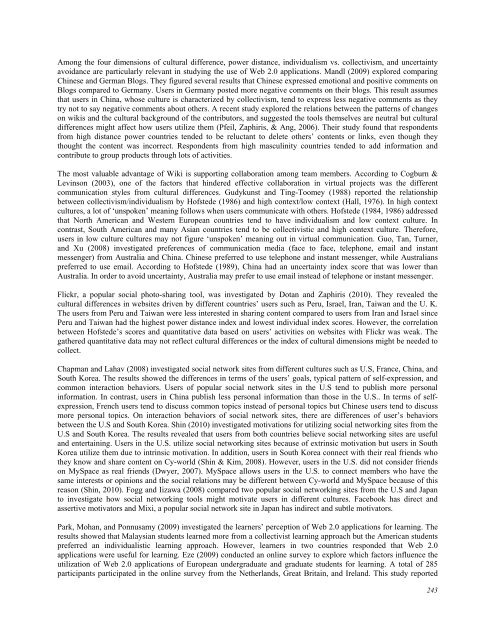October 2011 Volume 14 Number 4 - Educational Technology ...
October 2011 Volume 14 Number 4 - Educational Technology ...
October 2011 Volume 14 Number 4 - Educational Technology ...
You also want an ePaper? Increase the reach of your titles
YUMPU automatically turns print PDFs into web optimized ePapers that Google loves.
Among the four dimensions of cultural difference, power distance, individualism vs. collectivism, and uncertainty<br />
avoidance are particularly relevant in studying the use of Web 2.0 applications. Mandl (2009) explored comparing<br />
Chinese and German Blogs. They figured several results that Chinese expressed emotional and positive comments on<br />
Blogs compared to Germany. Users in Germany posted more negative comments on their blogs. This result assumes<br />
that users in China, whose culture is characterized by collectivism, tend to express less negative comments as they<br />
try not to say negative comments about others. A recent study explored the relations between the patterns of changes<br />
on wikis and the cultural background of the contributors, and suggested the tools themselves are neutral but cultural<br />
differences might affect how users utilize them (Pfeil, Zaphiris, & Ang, 2006). Their study found that respondents<br />
from high distance power countries tended to be reluctant to delete others’ contents or links, even though they<br />
thought the content was incorrect. Respondents from high masculinity countries tended to add information and<br />
contribute to group products through lots of activities.<br />
The most valuable advantage of Wiki is supporting collaboration among team members. According to Cogburn &<br />
Levinson (2003), one of the factors that hindered effective collaboration in virtual projects was the different<br />
communication styles from cultural differences. Gudykunst and Ting-Toomey (1988) reported the relationship<br />
between collectivism/individualism by Hofstede (1986) and high context/low context (Hall, 1976). In high context<br />
cultures, a lot of ‘unspoken’ meaning follows when users communicate with others. Hofstede (1984, 1986) addressed<br />
that North American and Western European countries tend to have individualism and low context culture. In<br />
contrast, South American and many Asian countries tend to be collectivistic and high context culture. Therefore,<br />
users in low culture cultures may not figure ‘unspoken’ meaning out in virtual communication. Guo, Tan, Turner,<br />
and Xu (2008) investigated preferences of communication media (face to face, telephone, email and instant<br />
messenger) from Australia and China. Chinese preferred to use telephone and instant messenger, while Australians<br />
preferred to use email. According to Hofstede (1989), China had an uncertainty index score that was lower than<br />
Australia. In order to avoid uncertainty, Australia may prefer to use email instead of telephone or instant messenger.<br />
Flickr, a popular social photo-sharing tool, was investigated by Dotan and Zaphiris (2010). They revealed the<br />
cultural differences in websites driven by different countries’ users such as Peru, Israel, Iran, Taiwan and the U. K.<br />
The users from Peru and Taiwan were less interested in sharing content compared to users from Iran and Israel since<br />
Peru and Taiwan had the highest power distance index and lowest individual index scores. However, the correlation<br />
between Hofstede’s scores and quantitative data based on users’ activities on websites with Flickr was weak. The<br />
gathered quantitative data may not reflect cultural differences or the index of cultural dimensions might be needed to<br />
collect.<br />
Chapman and Lahav (2008) investigated social network sites from different cultures such as U.S, France, China, and<br />
South Korea. The results showed the differences in terms of the users’ goals, typical pattern of self-expression, and<br />
common interaction behaviors. Users of popular social network sites in the U.S tend to publish more personal<br />
information. In contrast, users in China publish less personal information than those in the U.S.. In terms of selfexpression,<br />
French users tend to discuss common topics instead of personal topics but Chinese users tend to discuss<br />
more personal topics. On interaction behaviors of social network sites, there are differences of user’s behaviors<br />
between the U.S and South Korea. Shin (2010) investigated motivations for utilizing social networking sites from the<br />
U.S and South Korea. The results revealed that users from both countries believe social networking sites are useful<br />
and entertaining. Users in the U.S. utilize social networking sites because of extrinsic motivation but users in South<br />
Korea utilize them due to intrinsic motivation. In addition, users in South Korea connect with their real friends who<br />
they know and share content on Cy-world (Shin & Kim, 2008). However, users in the U.S. did not consider friends<br />
on MySpace as real friends (Dwyer, 2007). MySpace allows users in the U.S. to connect members who have the<br />
same interests or opinions and the social relations may be different between Cy-world and MySpace because of this<br />
reason (Shin, 2010). Fogg and Iizawa (2008) compared two popular social networking sites from the U.S and Japan<br />
to investigate how social networking tools might motivate users in different cultures. Facebook has direct and<br />
assertive motivators and Mixi, a popular social network site in Japan has indirect and subtle motivators.<br />
Park, Mohan, and Ponnusamy (2009) investigated the learners’ perception of Web 2.0 applications for learning. The<br />
results showed that Malaysian students learned more from a collectivist learning approach but the American students<br />
preferred an individualistic learning approach. However, learners in two countries responded that Web 2.0<br />
applications were useful for learning. Eze (2009) conducted an online survey to explore which factors influence the<br />
utilization of Web 2.0 applications of European undergraduate and graduate students for learning. A total of 285<br />
participants participated in the online survey from the Netherlands, Great Britain, and Ireland. This study reported<br />
243

















